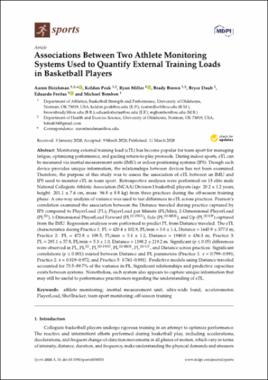| dc.contributor.author | Heishman, Aaron | |
| dc.contributor.author | Peak, Keldon | |
| dc.contributor.author | Miller, Ryan | |
| dc.contributor.author | Brown, Brady | |
| dc.contributor.author | Daub, Bryce | |
| dc.contributor.author | Freitas, Eduardo | |
| dc.contributor.author | Bemben, Michael G. | |
| dc.date.accessioned | 2020-05-20T18:15:16Z | |
| dc.date.available | 2020-05-20T18:15:16Z | |
| dc.date.issued | 2020-03-11 | |
| dc.identifier.citation | Heishman, A.; Peak, K.; Miller, R.; Brown, B.; Daub, B.; Freitas, E.; Bemben, M. 2020. Associations Between Two Athlete Monitoring Systems Used to Quantify External Training Loads in Basketball Players. Sports, 8, 33. | en_US |
| dc.identifier.uri | https://hdl.handle.net/11244/324425 | |
| dc.description.abstract | Monitoring external training load (eTL) has become popular for team sport for managing fatigue, optimizing performance, and guiding return-to-play protocols. During indoor sports, eTL can be measured via inertial measurement units (IMU) or indoor positioning systems (IPS). Though each device provides unique information, the relationships between devices has not been examined. Therefore, the purpose of this study was to assess the association of eTL between an IMU and IPS used to monitor eTL in team sport. Retrospective analyses were performed on 13 elite male National Collegiate Athletic Association (NCAA) Division I basketball players (age: 20.2 ± 1.2 years, height: 201.1 ± 7.6 cm, mass: 96.8 ± 8.8 kg) from three practices during the off-season training phase. A one-way analysis of variance was used to test differences in eTL across practices. Pearson’s correlation examined the association between the Distance traveled during practice captured by IPS compared to PlayerLoad (PL), PlayerLoad per Minute (PL/Min), 2-Dimensional PlayerLoad (PL2D), 1-Dimensional PlayerLoad Forward (PL1D-FWD), Side (PL1D-SIDE), and Up (PL1D-UP) captured from the IMU. Regression analyses were performed to predict PL from Distance traveled. The eTL characteristics during Practice 1: PL = 420.4 ± 102.9, PL/min = 5.8 ± 1.4, Distance = 1645.9 ± 377.0 m; Practice 2: PL = 472.8 ± 109.5, PL/min = 5.1 ± 1.2, Distance = 1940.0 ± 436.3 m; Practice 3: PL = 295.1 ± 57.8, PL/min = 5.3 ± 1.0, Distance = 1198.2 ± 219.2 m. Significant (p ≤ 0.05) differences were observed in PL, PL2D, PL1D-FWD, PL1D-SIDE, PL1D-UP, and Distance across practices. Significant correlations (p ≤ 0.001) existed between Distance and PL parameters (Practice 1: r = 0.799–0.891; Practice 2: r = 0.819–0.972; and Practice 3: 0.761–0.891). Predictive models using Distance traveled accounted for 73.5–89.7% of the variance in PL. Significant relationships and predictive capacities exists between systems. Nonetheless, each system also appears to capture unique information that may still be useful to performance practitioners regarding the understanding of eTL. | en_US |
| dc.description.sponsorship | Open Access fees paid for in whole or in part by the University of Oklahoma Libraries. | en_US |
| dc.language | en_US | en_US |
| dc.rights | Attribution 4.0 International | * |
| dc.rights.uri | https://creativecommons.org/licenses/by/4.0/ | * |
| dc.subject | athlete monitoring | en_US |
| dc.subject | inertial measurement unit | en_US |
| dc.subject | ultra-wide band | en_US |
| dc.subject | accelerometer | en_US |
| dc.subject | PlayerLoad | en_US |
| dc.subject | ShotTracker | en_US |
| dc.subject | team sport monitoring | en_US |
| dc.subject | off-season training | en_US |
| dc.title | Associations Between Two Athlete Monitoring Systems Used to Quantify External Training Loads in Basketball Players | en_US |
| dc.type | Article | en_US |
| dc.description.peerreview | Yes | en_US |
| dc.identifier.doi | 10.3390/sports8030033 | en_US |
| ou.group | College of Arts and Sciences::Department of Health and Exercise Science | en_US |

